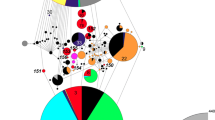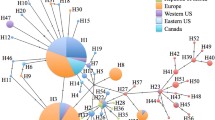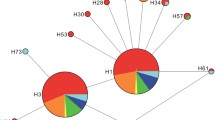Abstract
Identifying the origin of a biological invasion has important applications to the effective control of the invaders. This is more critical for invasive agricultural pests that cause severe economic losses. The brown marmorated stink bug, Halyomorpha halys, originally from East Asia, has become a principal agricultural pest in the US since its first detection in Pennsylvania in 1996. This species is responsible for crop failures on many mid-Atlantic farms and current control efforts rely on heavy insecticide applications because no other options are available. To examine the genetic diversity and identify the source region of the US introductions, we sequenced portions of the mitochondrial cytochrome c oxidase subunit II gene, 12S ribosomal RNA gene and control region in populations from the US, China, South Korea and Japan. We detected high genetic divergence among native populations and traced the origin of US H. halys to the Beijing area in China. We observed much lower genetic diversity in exotic compared to native populations—two mitochondrial haplotypes in 55 US specimens versus 43 haplotypes in 77 native specimens. A single introduction of small propagule size matches the invasion history in the US. For the effective control of the US population, we suggest that surveys on egg parasitoids and insecticide resistance in natives should focus on the Beijing area in China.





Similar content being viewed by others
References
Arakawa R, Namura Y (2002) Effects of temperature on development of three Trissolcus spp. (Hymenoptera: Scelionidae), egg parasitoids of the brown marmorated stink bug, Halyomorpha halys (Hemiptera: Pentatomidae). Entomol Sci 5:215–218
Caldera EJ, Ross KG, DeHeer CJ, Shoemaker DD (2008) Putative native source of the invasive fire ant Solenopsis invicta in the USA. Biol Invasions 10:1457–1479
Clement M, Posada D, Crandall KA (2000) TCS: a computer program to estimate gene genealogies. Mol Ecol 9:1657–1659
Corin SE, Lester PJ, Abbott KL, Ritchie PA (2007) Inferring historical introduction pathways with mitochondrial DNA: the case of introduced Argentine ants (Linepithema humile) into New Zealand. Divers Distrib 13:510–518
Dlugosch KM, Parker IM (2008) Founding events in species invasions: genetic variation, adaptive evolution, and the role of multiple introductions. Mol Ecol 17:431–449
Edgar RC (2004) MUSCLE: multiple sequence alignment with high accuracy and high throughput. Nucleic Acids Res 32:1792–1797
Engelstädter J, Telschow A (2009) Cytoplasmic incompatibility and host population structure. Heredity 103:196–207
Excoffier L, Lischer HEL (2010) Arlequin suite ver 3.5: a new series of programs to perform population genetics analyses under Linux and Windows. Mol Ecol Resources 10:564–567
Ficetola GF, Bonin A, Miaud C (2008) Population genetics reveals origin and number of founders in a biological invasion. Mol Ecol 17:773–782
Fogain R, Graff S (2011) First records of the invasive pest, Halyomorpha halys (Hemiptera: Pentatomidae) in Ontario and Quebec. J Entomol Soc Ont 142:45–48
Fu YX (1997) Statistical tests of neutrality of mutations against population growth, hitchhiking and background selection. Genetics 147:915–925
Funayama K (2004) Importance of apple fruits as food for the brown marmorated stink bug, Halyomorpha halys (Stål) (Heteroptera: Pentatomidae). Appl Entomol Zool 39:617–623
Grapputo A, Boman S, Lindström L, Lyytinen A, Mappes J (2005) The voyage of an invasive species across continents: genetic diversity of North American and European Colorado potato beetle populations. Mol Ecol 14:4207–4219
Haag-Liautard C, Coffey N, Houle D, Lynch M, Charlesworth B, Keightley PD (2008) Direct estimation of the mitochondrial DNA mutation rate in Drosophila melanogaster. PLoS Biol 6:e204. doi:10.1371/journal.pbio.0060204
Harris AC (2010) Halyomorpha halys (Hemiptera: Pentatomidae) and Protaetia brevitarsis (Coleoptera: Scarabaeidae: Cetoniinae) intercepted in Dunedin. The Weta 40:42–44
Hoebeke ER, Carter ME (2003) Halyomorpha halys (Stål) (Heteroptera: Pentatomidae): a polyphagous plant pest from Asia newly detected in North America. Proc Entomol Soc Washington 105:225–237
Hoffman WE (1931) A pentatomid pest of growing beans in South China. Peking Natural History Bull 5:25–26
Holtz T, Kamminga K (2010) Qualitative analysis of the pest risk potential of the brown marmorated stink bug (BMSB), Halyomorpha halys (Stål), in the United States. USDA APHIS PPQ. http://www.michigan.gov/documents/mda/BMSB_Pest_Risk_Potential_-_USDA_APHIS_Nov_2011_344862_7.pdf. Accessed 14 June 2013
Jenkins TM, Eaton TD (2011) Population genetic baseline of the first plataspid stink bug symbiosis (Hemiptera: Heteroptera Plataspidae) reported in North America. Insects 2:264–272
Jeyaprakash A, Hoy MA (2000) Long PCR improves Wolbachia DNA amplification: wsp sequences found in 76% of sixty-three arthropod species. Insect Mol Bio 9:393–405
Jones JR, Lambdin PL (2009) New county and state records for Tennessee of an exotic pest, Halyomorpha halys (Hemiptera: Pentatomidae), with potential economic and ecological implications. Fla Entomol 92:177–178
Kawada H, Kitamura C (1992) The tachinid fly, Bogosia sp. (Diptera: Tachinidae), as a parasitoid of the brown marmorated stink bug, Halyomorpha mista Uhler (Heteroptera: Pentatomidae). Jpn J Environ Entomol Zool 4:65–70
Kidd NAC, Jervis MA (2007) Population dynamics. In: Jervis MA (ed) Insects as natural enemies: a practical perspective. Springer, Dordrecht, pp 435–523
Kikuchi Y, Hosokawa T, Fukatsu T (2008) Diversity of bacterial symbiosis in stinkbugs. In: Dijk TV (ed) Microbial ecology research trends. Nova Publishers, New Yok, pp 39–64
Kobayashi T, Hasegawa T, Kegasawa K (1972) Major insect pests of leguminous crops in Japan. Trop Agric Res Ser 6:109–126
Kolbe JJ, Glor RE, Rodriguez Schettino L, Lara AC, Larson A, Losos JB (2004) Genetic variation increases during biological invasion by a Cuban lizard. Nature 431:177–181
Koppel AL, Herbert DA Jr, Kuhar TP, Kamminga K (2009) Survey of stink bug (Hemiptera: Pentatomidae) egg parasitoids in wheat, soybean, and vegetable crops in southeast Virginia. Environ Entomol 38:375–379
Kuhar TP, Kamminga KL, Whalen J, Dively GP, Brust G, Hooks CRR, Hamilton G, Herbert DA (2012) The pest potential of brown marmorated stink bug on vegetable crops. Online. Plant Health Prog. doi:10.1094/PHP-2012-0523-01-BR
Leskey TC, Hamilton GC (2010) Brown marmorated stink bug working group progress report. http://projects.ipmcenters.org/Northeastern/FundedProjects/ReportFiles/Pship2010/Pship2010_Lesky_ProgressReport_237195_meeting2010_11_17.pdf. Accessed 27 July 2011
Leskey TC, Hamilton GC, Nielsen AL et al (2012) Pest status of the brown marmorated stink bug, Halyomorpha halys in the USA. Outlooks Pest Manag 23:218–226.
Librado P, Rozas J (2009) DnaSP v5: a software for comprehensive analysis of DNA polymorphism data. Bioinformatics 25:1451–1452
Nielsen AL, Hamilton GC (2009) Life history of the invasive species Halyomorpha halys (Hemiptera: Pentatomidae) in northeastern United States. Ann Entomol Soc Am 102:608–616
Nielsen AL, Hamilton GC, Shearer PW (2011) Seasonal phenology and monitoring of the non-native Halyomorpha halys (Hemiptera: Pentatomidae) in soybean. Env Entomol 40:231–238
Nylander JAA (2004) MrModeltest v2. Program distributed by the author. Evolutionary Biology Centre, Uppsala University, Sweden
Peakall R, Smouse PE (2006) GENALEX 6: genetic analysis in Excel. Population genetic software for teaching and research. Mol Ecol Notes 6:288–295
Posada D, Crandall KA (1998) MODELTEST: testing the model of DNA substitution. Bioinformatics 14:817–818
Posada D, Crandall KA, Templeton AR (2000) GeoDis: a program for the cladistics nested analysis of the geographical distribution of genetic haplotypes. Mol Ecol 9:487–488
Rambaut A, Drummond AJ (2003). TRACER: MCMC trace analysis tool. Available from: http://evolve.zoo.ox.ac.uk. University of Oxford, Oxford
Rice WR (1989) Analyzing tables of statistical tests. Evolution 43:223–225
Rogers AR, Harpending H (1992) Population growth makes waves in the distribution of pairwise genetic differences. Mol Biol Evol 19:552–569
Ronquist F, Huelsenbeck JP (2003) MrBayes 3: Bayesian phylogenetic inference under mixed models. Bioinformatics 19:1572–1574
Seetin M (2011) News release: losses to mid-Atlantic apple growers at $37 million from brown marmorated stink bug. http://www.growingproduce.com/article/21057/brown-marmorated-stink-bug-causes-37-million-in-losses-to-mid-atlantic-apple-growers. Accessed 30 Apr 2012
Shufran KA, Kirkman LR, Puterka GJ (2007) Absence of mitochondrial DNA sequence variation in Russian wheat aphid (Hemiptera: Aphididae) populations consistent with a single introduction into the United States. J Kansas Entomol Soc 80:319–326
Tamura K, Nei M (1993) Estimation of the number of nucleotide substitutions in the control region of mitochondrial DNA in humans and chimpanzees. Mol Biol Evol 10:512–526
Teixeira LAF, Polavarapu S (2003) Evolution of phenologically distinct populations of Rhagoletis mendax (Diptera: Tephritidae) in highbush blueberry fields. Annals Entomol Soc Am 96:818–827
Tsutsui ND, Suarez AV, Holway DA, Case TJ (2000) Reduced genetic variation and the success of an invasive species. Proc Natl Acad Sci 97:5948–5953
Wermelinger B, Wyniger D, Forster B (2008) First records of an invasive bug in Europe: Halyomorpha halys (Stål) (Heteroptera: Pentatomidae), a new pest on woody ornamentals and fruit trees? Bull Entomol Suisse 81:1–8
Xu J, Fonseca DM (2011) One-way sequencing of multiple amplicons from tandem repetitive mitochondrial DNA control region. Mitochondrial DNA 22:155–158
Yang Z-Q, Yao Y-X, Qiu L-F, Li Z-X (2009) A new species of Trissolcus (Hymenoptera: Scelionidae) parasitizing eggs of Halyomorpha halys (Heteroptera: Pentatomidae) in China with comments on its biology. Ann Entomol Soc Am 102:39–47
Zhou W, Rousset F, O’Neill S (1998) Phylogeny and PCR-based classification of Wolbachia strains using wsp gene sequences. Proc R Soc Lond B 265:509–515
Zhu G, Bu W, Gao Y, Liu G (2012) Potential geographic distribution of brown marmorated stink bug invasion (Halyomorpha halys). PLoS One 7:e31246
Acknowledgments
We are greatly appreciative of the assistance of A. Koppel, L. Zhang, M.-Z. Lin, F. Chen, S. H. Lee, H. J. Kim, S. H. Jung and M. Toyama in collecting specimens from the native range. We are indebted to all the homeowners who enthusiastically provided us with specimens and information. Citizen Science is an important resource in our fight against invasive species. This study was funded in part by NJAES Hatch projects 08191 and 0211785.
Author information
Authors and Affiliations
Corresponding author
Electronic supplementary material
Below is the link to the electronic supplementary material.
Rights and permissions
About this article
Cite this article
Xu, J., Fonseca, D.M., Hamilton, G.C. et al. Tracing the origin of US brown marmorated stink bugs, Halyomorpha halys . Biol Invasions 16, 153–166 (2014). https://doi.org/10.1007/s10530-013-0510-3
Received:
Accepted:
Published:
Issue Date:
DOI: https://doi.org/10.1007/s10530-013-0510-3




